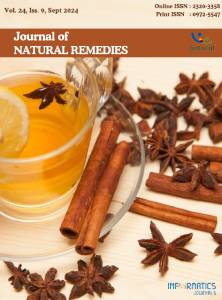High Performance Thin Layer Chromatographic Method for Simultaneous Estimation of Vitamin C, Thymoquinone and Thymol in Plant Extracts
DOI:
https://doi.org/10.18311/jnr/2024/36155Keywords:
Anti-hypertensive, Dragon Fruit, Hylocereus polyrhizus, Kali Jiri, Nigella sativa, Seed ExtractAbstract
Background: Lack of an effective HPTLC simultaneous estimation method for vitamin C, thymoquinone and thymol in plant extracts. Aim: The present study involves the development of an accurate, precise, specific, and specific HPTLC method for the identification and quantification of three phytomarkers thymol and thymoquinone in Nigella sativa (kali jiri) seed extract and vitamin C in Hylocereus polyrhizus (dragon fruit) extract. Methods: Using an aluminum plate pre-coated with silica gel 60 F254 and methanol-n hexane-ammonia (15%) (8.5:1.5:0.2 v/v/v) as the mobile phase, thin layer chromatographic development was performed. Results: For each of the three markers, densitometric quantification was carried out at the isobestic point of 271 nm. Vitamin C, thymol, and thymoquinone bands were separated chromatographically at Rf values of 0.66, 0.35, and 0.19, respectively, by using developed mobile phase. For thymol, thymoquinone, and vitamin C, linearity range was 2000-8000 ng/band. The three markers showed 99.39%–99.91% recovery for thymol, 99.22%–99.89% recovery for thymoquinone, and 99.19%–99.69% recovery for vitamin C. Conclusion: The optimized method was used to quantify three thymol and thymoquinone in N. sativa (kali jiri) seed extract and vitamin C in H. polyrhizus (dragon fruit) extract.
Downloads
Metrics
Downloads
Published
How to Cite
License
Copyright (c) 2024 Sweta Patel, Falguni Tandel, Guno Chakraborthy (Author)

This work is licensed under a Creative Commons Attribution 4.0 International License.
Accepted 2024-07-30
Published 2024-10-07
References
Nguyen H, Odelola OA, Rangaswami J, Amanullah A. A review of nutritional factors in hypertension management. J Hypertens. 2013. https://doi.org/10.1155/2013/698940
Agrawal M, Nandini D, Sharma V, Chauhan NS. Herbal remedies for treatment of hypertension. Int J Pharm Sci and Res. 2010; 1(5):1-21. http://dx.doi.org/10.13040/ IJPSR.0975-8232.1(5).1-21
Mashour NH, Lin GI, Frishman WH. Herbal medicine for the treatment of cardiovascular disease: Clinical considerations. Arch Intern Med. 1998; 158(20):2225-2234. https://doi.org/10.1001/archinte.158.20.2225
Ahmad A, Husain A, Mujeeb M, Khan SA, Najmi AK, Siddique NA, Damanhouri ZA, Anwar F. A review on therapeutic potential of N. sativa: A miracle herb. Asian Pac J Trop Biomed. 2013; 3(5):337-352. https://doi.org/10.1016/ s2221-1691(13)60075-1
Yimer EM, Tuem KB, Karim A, Ur-Rehman N, Anwar F. Nigella sativa L. (black cumin): A promising natural remedy for wide range of illnesses. J Evid Based Complementary Altern Med. 2019. https://doi.org/10.1155/2019/1528635
Srinivasan K. Cumin (cuminum cyminum) and black cumin (Nigella sativa) seeds: Traditional uses, chemical constituents, and nutraceutical effects. Food quality and safety. 2018; 2(1):1-6. https://doi.org/10.1093/fqsafe/fyx031
Aljabre SHM, Alakloby OM, Randhawa MA. Dermatological effects of Nigella sativa. J Dermatol Surg. 2015; 19(2):92-98. https://doi.org/10.1016/j.jdds.2015.04.002
Perween T, Mandal KK, Hasan MA. Dragon fruit: An exotic super future fruit of India. J Pharmacogn Phytochem. 2018; 7(2):1022-1026.
Sonawane MS. Nutritive and medicinal value of dragon fruit. Asian J Hort. 2017; 12(2):267-71. https://doi.org/10.15740/ has/tajh/12.2/267-271
Setiawan NA, Shintawati R, Priyandoko D. The role of red dragon fruit peel (Hylocereus polyrhizus) to improvement blood lipid levels of hyperlipidaemia male mice. J Phys. 2018; 1013:012167. https://doi.org/10.1088/1742-6596/1013/1/012167
Nurliyana R, Zahir IS, Suleiman KM. Antioxidant study of pulps and peels of dragon fruits: A comparative study. Int J Food Sci. 2010; 17(2):367-75.
Belete Y, Dagne E. HPTLC assay of thymoquinone in black seed and black seed oil (Nigella sativa Linn) and identification of thymoquinone conversion with Uv-Vis. J Drug Deliv Ther. 2014; 4(4):5-9. https://doi.org/10.22270/jddt.v4i4.895
Taleuzzaman M, Imam SS, Gilani SJ. Quantitative determination of thymoquinone in Nigella sativa and its nano formulation using validated stability indicating HPTLC densiometric method. Int Curr Pharm J. 2017; 6(10):53-60. https://doi.org/10.3329/icpj.v6i10.35897
Alam P, Yusufoglu H, Alam A. HPTLC densitometric method for analysis of thymoquinone in Nigella sativa extracts and marketed formulations. Asian Pac J Trop Dis. 2013; 3(6):467471. https://doi.org/10.1016/s2222-1808(13)60102-4
Basha LA, Rashed MS, Aboul-Enein HY. TLC assay of thymoquinone in black seed oil (Nigella sativa Linn) and identification of dithymoquinone and thymol. J Liq Chromatogr Relat Technol. 1995; 18(1):105-115. https:// doi.org/10.1080/10826079508009224
Alqarni MH, Foudah AI, Alam A, Salkini MA, Alam P, Yusufoglu HS. Novel HPTLC-densitometric method for concurrent quantification of linalool and thymol in essential oils. Arab J Chem. 2021; 14(2):102916. https://doi.org/10.1016/j.arabjc.2020.102916
Sherman HC, LaMer VK, Campbell HL. The quantitative determination of the antiscorbutic vitamin (vitamin C). J Am Chem Soc. 1922; 44(1):165-172. https://doi.org/10.1021/ja01422a021
Abdelwahab NS, Abdelaleem EA, Abdelrahman MM. HPTLC-densitometric method for determination of ascorbic acid, paracetamol and guaifenesin in presence of their toxic impurities. J Chromatogr Sci. 2019; 57(2):149-155. https://doi.org/10.1093/chromsci/bmy096
Chakraborthy GS. Quantitative estimation of ascorbic acid by HPTLC in different varieties of amla. J Young Pharm 2009; 1(1):82. https://doi.org/10.4103/0975-1483.51878
Borman P, Elder D. Q2 (R1) validation of analytical procedures: Text and methodology. ICH Quality Guidelines: An Implementation Guide. 2017; p. 127-166. https://doi.org/10.1002/9781118971147.ch5

 Sweta Patel
Sweta Patel









 0.35
0.35 24
24 0.161
0.161